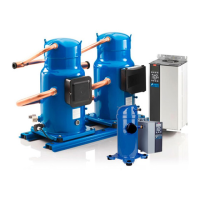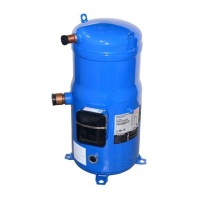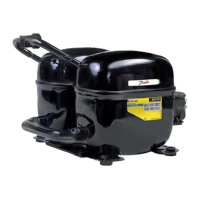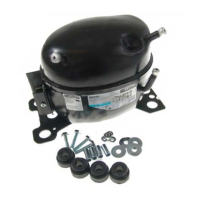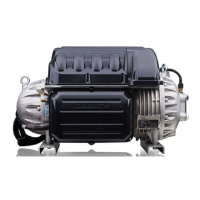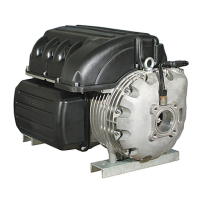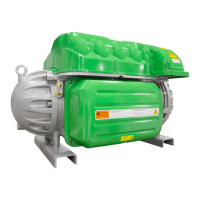Heat pumps frequently utilize high condensing
temperatures in order to achieve a sucient
temperature rise in the medium being heated.
At the same time, they often require low
evaporating pressures to obtain sucient
temperature dierentials between the evaporator
and the outside temperature. This situation may
result in high discharge temperature; as such, it is
mandatory that a discharge gas safety control is
carried to protect the compressor from excessive
temperatures. Operating the compressor at
too high discharge temperatures can result
in mechanical damage to the compressor as
well as thermal degradation of the compressor
lubricating oil and a lack of sucient lubrication.
Refer to section “Discharge gas temperature
protection” function for frequency converter
settings and accessories availability.
Discharge temperature
monitoring
Specic application recommendations
Discharge line and reversing
valve
Defrost and reverse cycle
The VZH scroll compressor is a high volumetric
machine and, as such, can rapidly build up
pressure in the discharge line if gas in the line
becomes obstructed even for a very short period
of time which situation may occur with slow-
acting, reversing valves in heat pumps. Discharge
pressures exceeding the operating envelope may
result in nuisance high-pressure switch cutouts
and can generate excessive load on bearings and
motor.
To prevent such occurrences, it is important that
a 1-meter minimum discharge line length be
allowed between the compressor discharge port
and the reversing valve or any other restriction.
This gives sucient free volume for the discharge
gas to collect and to reduce the pressure peak
during the time it takes for the valve to change
position. At the same time, it is important that
the selection and sizing of the reversing or 4-way
valve ensure that the valve switches quickly
enough to prevent against too high discharge
pressure and nuisance high-pressure cutouts.
Check with the valve manufacturer for optimal
sizing and recommended mounting positions.
It is strongly recommended to reduce the
compressor speed to 25/30 rps before the 4-way
valve is moved from a position to another.
Refer also to high and low pressure protection.
After the 4-way valve is moved to defrost
position, and in order to shorten the defrost
period, the compressor speed can be maintained
at 70 rps during the defrost period.
When the compressor is started again, after
defrost, it will run at 25/30 rps for a 10 seconds
period. After this period it is recommended to
maintain the speed at 50 rps for 10 to 15 seconds.
Thus to avoid excessive liquid refrigerant to come
back to the compressor sump.
In order to check liquid ood back during defrost
cycle, the defrost test must be carried out in the
most unfavorable condition, at 0°C evaporating
temperature.
During defrost test, liquid ood back can be
detected by either measuring oil superheat or
monitoring drive alarm. If at any time during
defrost operations, the oil superheat drops to the
unsafety area in the Dilution Chart (see graph in
the section “Liquid oodback during operation”),
or drive alarm A49 (or A18) occurs, this indicates
liquid ood back. In such cases a suction
accumulator is mandatory.
The suction accumulator oers protection by
trapping the liquid refrigerant upstream from the
compressor. The accumulator should not be sized
for less than 50% of the total system charge.
Defrost test
52 FRCC.PC.023.A8.02
Application Guidelines
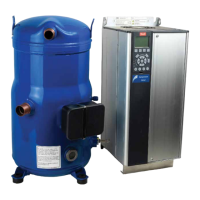
